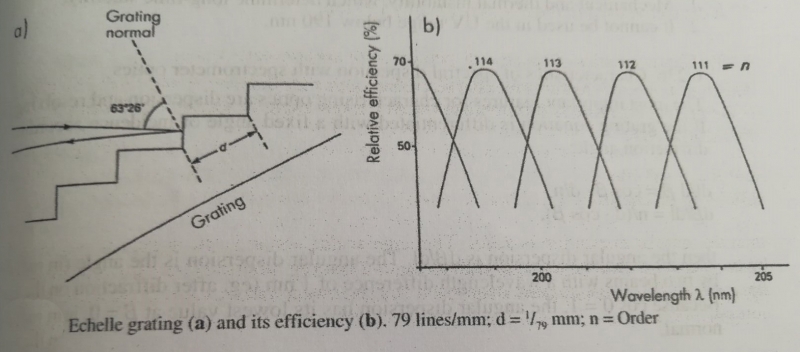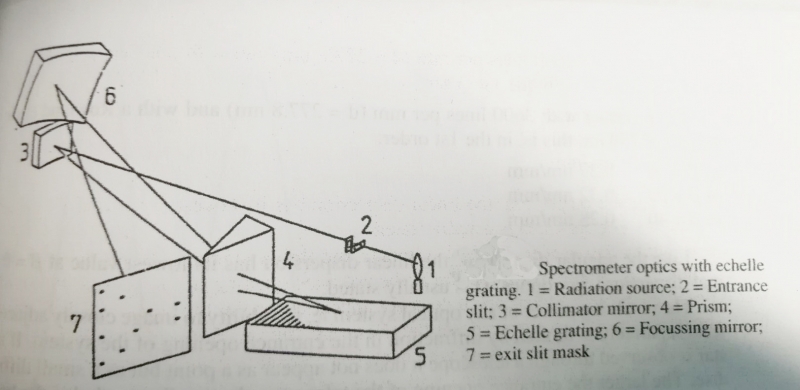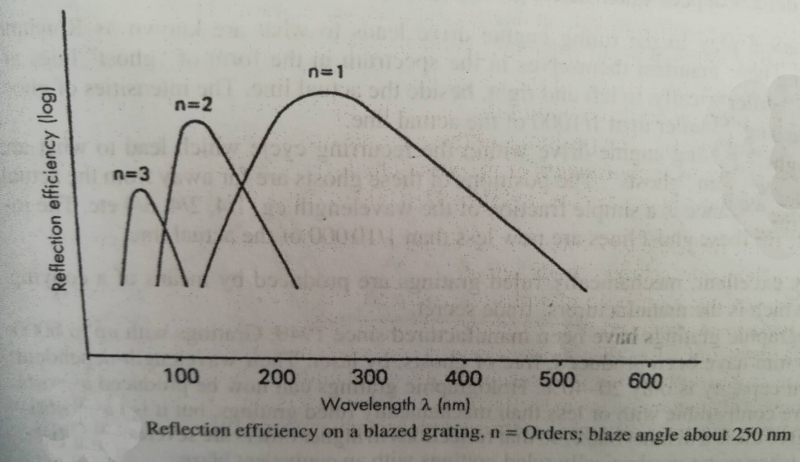Spectrometer optics with echelle grating
Resolving power and the useful spectral wavelength range are two mutually opposed parameters, so that occasionally measurements have to be made in the 2nd or 3rd order. Grating efficiency in higher order is critically dependent on the blaze angle or the associated wavelength.
Another possible method of improving resolution is to cover the spectral range with numerous diffraction orders. This principle is applied in the echelle grating. As a rule, echelle grating have a large blaze angle, typically 63°26′,making it impossible to improve resolution by more than a power of ten(Fig. 1)

Fig.1
Echelle grating differ further from conventional grating In their line density. Echelle grating usually have a line density of 2400 lines /mm. In order to obtain larger values for θ or sinθ it is necessary to work in high orders of diffraction. The advantage of this configuration lies in the fact that each order only covers a small range of θ. An echelle grating thus always works in the direct vicinity of the blaze angle and guarantees high resolution. The echelle configuration is also one of the most efficient grating with respect to radiation yield. In no case is the radiation yield less than 50% of the maximum possible.
If it does not reach 50%, an adjacent order is used which again lies in the direct vicinity of the blaze angle. In contrast to this, the radiation yield of conventional gratings which mainly work in the 1st order of diffraction is reduced with increasing distance from the blaze angle.(Fig. 2)

Fig.2
Various designs of spectrometers with echelle grating works with echelle grating are commercially available.
The greatest demands are made on the optical configuration since the echelle grating works with a high diffraction angle. In order to eliminate impairment of resolution by optical aberrations a special mounting must be selected for the optics and collimator mirror. The Ebert mounting has been replaced with the asymmetrical Czerny-Turner mounting I which asymmetry is exploited in order to compensate for aberrations. In addition, unwanted orders are filters out by means of primary monochromator.
In Fig. 3 the echelle grating and prism are arranged in parallel, with a prism broadening the diffraction order in the vertical direction, whereas the orders are vertically separated. This gives a two-dimensional spectrum on the spectrometer diaphragm plate.

Fig.3
To avoid overlaps, the orders must be separated. In the echelle configuration three different detectors systems can be used. In simultaneous spectrometers a CCD eg. coupled with a lightguide is allocated to each exit slit and corresponding wavelength. In sequential spectrometers a rotatable grating with an exit slit and CCD can be used to select the wavelength. In the third variant, a CCD is moved over a diaphragm plate with a number of exit slits. The preselected wavelengths are sequentially traversed by the CCD. The advantage of this arrangement is that optical components have to be moved.
In spite of the attractive optical properties with respect to resolving power and radiation power there are basically two disadvantages which repeatedly limited general use :
1. Mechanical and thermal instability, which determine long-time stabllity.
2.It cannot be used in the UV range below 130nm.


Address: 19th Liangtong Road, Mashan Town, Binhu District, Wuxi City, Jiangsu Province, China
Copyright ? 2015 All Rights Reserved